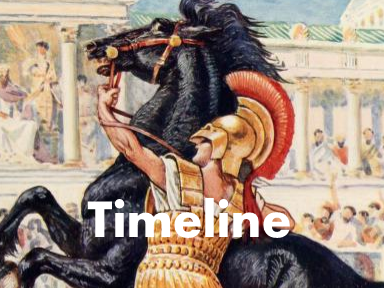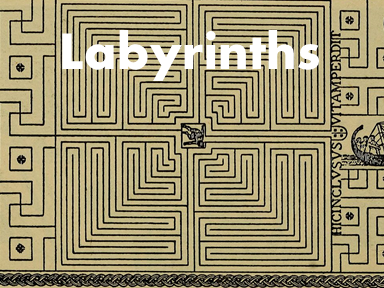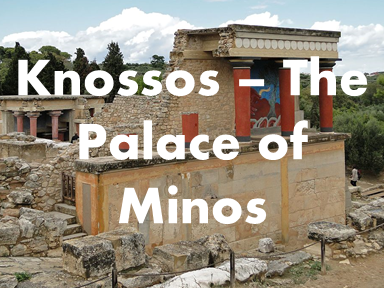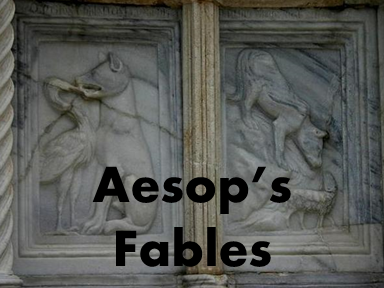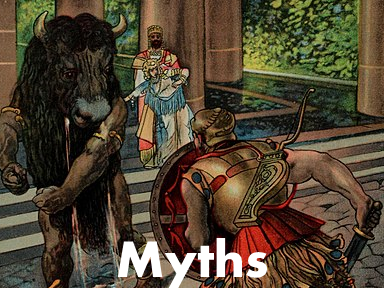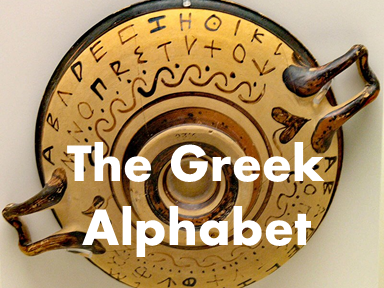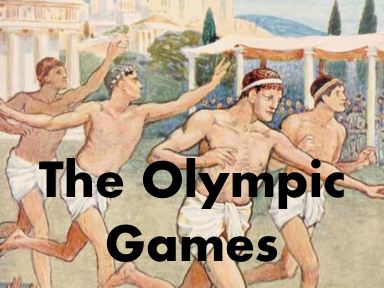Pottery
The Greeks, as well as people living in Aegean islands, the west coast of Asia minor, and southern Italy and Sicily, made beautiful vases as early as 6000 B. C. The finest vases were constructed in Athens. Vases were exported all over the Mediterranean area.

Attic Horse Pyxis
From 900-700 BC, known as the Geometric Period, patterns such as a meander pattern were used to decorate pottery vases. Spirals, diamonds, and crosshatching designs were popular.
Vases varied in quality from museum pieces to roughly constructed pieces. During the Mycenaean era, the vases began having simple symmetrical ornaments. Even during the Greek Dark Ages, pottery was produced. From 1200-900 BC, circular ornaments were used on the pottery.
Meander Art

Meander pavement in the streets of Rhodes


Vases
 Attic Black Figure Amphora
Attic Black Figure AmphoraGreek vases produced after the Orientalizing Period, which succeeded the Geometric Period, have figure scenes of everyday life of Ancient Greece, such as sports, banquets, weddings and funerals, and mythological scenes. These vases tell us a lot about everyday life in Greece. In these pieces the human figure was painted by a silhouette technique. During the seventh century vases were painted with animals such as panthers and birds. At this time the vases of Corinth were decorated with the black-figured technique.
 Attic Red Figure Stamnos
Attic Red Figure Stamnos Around 525 B. C. the potters of Athens discovered the red-figured technique.
Using the black-figure technique the artist drew the outline of the figure, then the inside of the design was painted. Colors such as white and blown-red were applied. Details were drawn by a pointed tool.
In the red-figure design the outlines of the figure was drawn and details were painted by a brush or other tools. Then outside was painted over. This new technique enabled the Greeks to draw the lines of different thickness or width.
By the late fifth century the Greeks were producing fewer vases because other cities around the Mediterranean begin producing their own vases.
Paintings
The Greeks made beautiful paintings. Unfortunately, none of these painting have survived time. The Romans took some back to Italy after their conquest of Greece. These were burned in fires. Apelles was one of the greatest painters.
Sculpture
During the Geometric Period from 900 to 700 BC, the Greeks built sculptures of bronze, wood, ivory, and clay.
During the Archaic Period from 600 to 480 BC, sculptures were carved from slabs and placed on the pediment space of a lot of buildings. This triangular space was filled with fallen soldiers and other men who gradually rose until there was a tall figure standing in the center.


The Museum at Olympia
Sculptures from the West Pediment of the Temple of Zeus
Battle of Lapiths and Centaurs
During the Classical Period from 480 to 450 BC, freestanding sculptures were done in a naturalistic style using high relief. Hollow cast bronze was also used. Later specific measurement for the perfectly proportioned body was used in the statues.
The Greeks made beautiful sculptures out of limestone and marble. Unfortunately many of them were burned during the Middle Ages to produce lime. The lime was used in cement. The Romans copied many of the Greek sculptures. Some of these have survived.

Funerary Stele for a woman late 5th century BC

480 - 445 B. C.
Discus-Thrower
height 155 cm (61 in)

Phidias
490 - 430 B. C.
carved the Statue of Athena
.

Praxitiles
390 - 330 B. C
"Hermes holding the baby Dionysus"
Coins

.

The Greeks produced their first coins in the seventh century BC. The coins were made of electrum which is an alloy of gold and silver. These coins were plain with no decoration on them. Later King Croisos produced coins of both gold and silver. These coins were decorated on the fronts with symbols of Lydia.
The first Greek mainland coins were made in Aigina, an island southwest of Athens. Soon many cities were making coins. At this time, new designs were used for the reverse side. When Athens rose as a central power, she refused to allow other cities to produce their own coins. Everyone used coins that were produced in Athens. These coins had the head of Athena on the front and the owl on the reverse. This policy lasted until the outbreak of the Peloponnesian War in 431 BC. At this time Athens relaxed her hold and many Aegean cities started to make their own coins again.
After Alexander the Great brought unification to Greece, he and his followers produced coins with their portraits, instead of gods or animals, to show off their power. Some other cities were still producing their own coins, but they were mainly made from bronze instead of silver. The designs became dull and unattractive.
Greek coins were named according to how much they weighed.
Jewelry
Many pieces of jewelry have been found by excavating burial sites of the Ancient Greeks. Masterpieces of exceptional workmanship have been found in Crete and other Aegean Islands where the Minoan Civilization prospered. Great pieces have also been found from the Mycenae Civilization which preceded the historical Greek Civilization. Many of the pieces were modeled after Homer's description of Achilles' shield, Aphrodite's girdle, and of the gold door knobs in the palace at Troy.
During the Geometric and Orientalizing Periods from 1000 to 800 BC, the art work showed little imagination. Quality jewelry began again shortly after 800 BC with refined techniques and delicate artistry. The Persian Wars had little effect on the high quality of jewelry that was being produced at the time. During the Classical Period that followed, the jewelry that was being produced was of such high quality that it looked like miniature sculptures. After Alexander the Great opened up the area, the influence of Oriental design can be seen in the jewelry.


